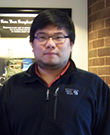X-RAY RUNS: Apply for Beamtime
2017 Nov 1 - Dec 21
2018 Feb 7 - Apr 3
2018 Proposal/BTR deadline: 12/1/17
2018 Apr 11 - Jun 4
2018 Proposal/BTR deadline: 2/1/18
With the availability of the Sample Environment Lab, CHESS staff scientist Detlef Smilgies, also an adjunct associate professor at the Cornell School of Chemical and Biomolecular Engineering, took three aspiring chemical engineers under his wings. As part of the Masters of Engineering (MEng) program students are expected to do a 3-6 credit design project and a 3-4 credit special project. The first bunch of D-line alumni shall be highlighted here.

George Guo came in with a BS in chemical engineering from the University of Wisconsin at Madison and an internship in industry. He took on a special project of building a proportional temperature controller for the D1-line sample stages that use Peltier elements for heating or cooling. Peltier elements have a low internal resistance and require large currents (typically 5 A - 25 A, depending on size). Standard temperature controllers use simple on/off control which is not ideal when large currents are involved. George used a temperature controller with a 0-10 V proportional output to control a voltage-programmable 25 A power supply. This way, rather than switching large loads, the current to the Peltier element is regulated in a continuous way. George verified his design with two Peltier stages and a temperature stage using a low-resistance heating wire and characterized their performance with an infrared heat camera. Moreover, he set up serial port connections, so that the device can be remote-controlled inside the D1 experimental hutch.
After graduating in May, George stayed on as a temporary technician at CHESS and worked on designing the next generation of coating stages for the D1 coating program. As a result of his work, an improved second knife-coating stage and a prototype slot-die coater came into existence, expertly machined by the CHESS shop and assembled by George. An improved version of the first design is essentially drawn up. In December George accepted a position as a process engineer at Brady Corporation in Milwaukee, a company specialized in coating anything from sticky labels to traffic signs.

Vincent Rosa came into the MEng program from a background in computer science, with a BS degree at Florida Gulf Coast University and several years of experience in industry. He decided to supplement his CV with a degree in chemical science. Vincent took on a 3-credit design project and a 4-credit special project in designing and building a vapor pressure control system. Interaction with solvent vapor as solvent vapor annealing and controlled drying has evolved into an important method in order to improve soft materials for organic electronics and nanostructures. However, it is not trivial providing quantifiable vapor pressures for a large variety of solvents with a large spectrum of boiling points, as are common in the field. The company Bronkhorst has developed a new approach where a controlled evaporator and mixer unit first evaporates solvents or solvent mixtures and then mixes and thermalizes the vapor with a carrier gas. This approach avoids some of the problems and pitfalls associated with conventional bubbler systems.
Vincent’s task was to design and build the system, so that it can be permanently installed in the D1 hutch. As of the time of this writing, the system is assembled and ready for testing. In addition, Vincent worked as a CHESS summer student on LabView programming to support the new temperature controller and the coating new stages built by George. Vincent graduated in December ’14 and recently accepted a job offer by SciTec, a Princeton-based company specializing in remote sensing.

As the youngest of the bunch, Patrick Dorion decided to switch to chemical engineering after having obtained a BS in chemistry at Cornell. Patrick took on a 6-credit design project over the summer and continued this work as a 3-credit special project of characterizing the adsorption of nanoparticles onto functionalized substrates from the solution phase. Nanoparticle coatings have a plethora of applications ranging from solar energy to biosensors and drug delivery. The goal of the study was to look into details of the adsorption process in thermal equilibrium with the solution phase. As main experimental probe served a quartz crystal microbalance with dissipation (QCM-D, Biolin Scientific).
Patrick mastered the procedures of functionalizing the sensors with high-quality self-assembled monolayers and devised a novel cleaning procedure for re-use of the sensors. For his project Patrick teamed up with graduate student Tom Derrien in Prof. Dan Luo’s group at Biological end Environmental Engineering, in order to study the attachment of DNA-coated gold nanoparticles from solution. Patrick developed procedures to obtain reliable results from the somewhat finicky QCM-D system for small sample volumes of valuable material, as synthesized by Tom, and explored a large range of adsorption conditions such as temperature, ionic strength, and pH. We plan to write up this study in a publication. In addition Patrick trained another MEng student, Matt Chang, in the use of the QCM-D system and mentored an undergraduate student who learned the basic QCM-D technique as part of an instrumentation class. Patrick graduated in December ’14 and has accepted a position as a field engineer with Infineum in Linden, New Jersey, a chemical company specialized in developing additives for fuels and lubricants.
It was very rewarding that all three students appreciated their working experience at CHESS as an asset for their job interviews. We congratulate our chemical engineering masters and wish them the best for their careers in industry!
Submitted by: Detlef Smilgies, CHESS, Cornell University
01/05/2015
